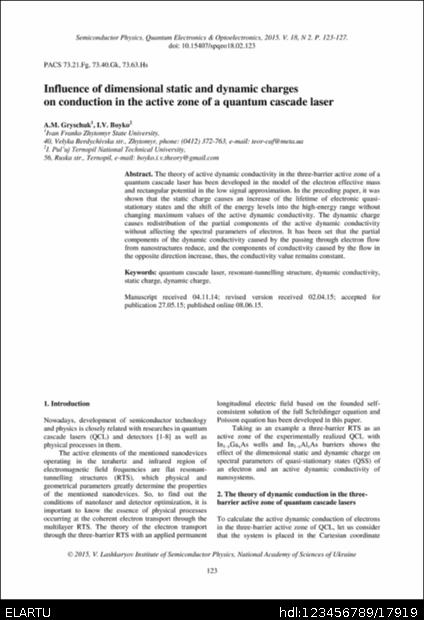Ezzel az azonosítóval hivatkozhat erre a dokumentumra forrásmegjelölésben vagy hiperhivatkozás esetén:
http://elartu.tntu.edu.ua/handle/123456789/17919

| Title: | Influence of dimensional static and dynamic charges on conduction in the active zone of a quantum cascade laser |
| Authors: | Грищук, Андрій Миколайович |
| Affiliation: | A.M . Gryschuk 1 , I.V. Boyko 2 1 Ivan Franko Zhytomyr State University, 40, Velyka Berdychivska str., Zhytomyr, phone: (0412) 372-763, e-mail: teor-caf@meta.ua 2 I. Pul’uj Ternopil National Technical University, 56, Ruska str., Ternopil, e -mail: boyko.i.v.theory@gmail.com |
| Bibliographic description (Ukraine): | 2015. V. 18, N 2. P. 123-127. |
| Bibliographic description (International): | Semiconductor Physics, Quantum Electronics & Optoelectronics. 2015. V. 18, N 2. P. 123-127. |
| Journal/Collection: | Semiconductor Physics, Quantum Electronics & Optoelectronics |
| Issue: | 2 |
| Volume: | 18 |
| Issue Date: | 8-jún-2015 |
| Submitted date: | 4-nov-2014 |
| Date of entry: | 19-sze-2016 |
| Publisher: | EBSCO PUBLISHING |
| UDC: | 538.935 538.915 538.971 |
| Keywords: | nanosystems quantum cascade laser resonant-tunnelling structure dynamic conductivity static charge dynamic charge |
| Number of pages: | 5 |
| Page range: | 123-127 |
| Series/Report no.: | 2015. V. 18;N 2. |
| Abstract: | The theory of active dynamic conductivity in the three-barrier active zone of a quantum cascade laser has been developed in the model of the electron effective mass and rectangular potential in the low signal approximation. In the preceding paper, it was shown that the static charge causes an increase of the lifetime of electronic quasi-stationary states and the shift of the energy levels into the high-energy range without changing maximum values of the active dynamic conductivity. The dynamic charge causes redistribution of the partial components of the active dynamic conductivity without affecting the spectral parameters of electron. It has been set that the partial components of the dynamic conductivity caused by the passing through electron flow from nanostructures reduce, and the components of conductivity caused by the flow in the opposite direction increase, thus, the conductivity value remains constant. |
| URI: | http://elartu.tntu.edu.ua/handle/123456789/17919 |
| Copyright owner: | © 2015, V. Lashkaryov Institute of Semiconductor Physics, National Academy of Sciences of Ukraine |
| References (International): | [1] J.M. Wolf, A. Bismuto, M. Beck, and J. Faist. Distributed-feedback quantum cascade laser emitting at 3.2 μm // Optics Express, 22(2), pp. 2111-2118 (2014). [2] D. Bachmann, M. Rösch, C. Deutsch, M. Krall, G. Scalari, M. Beck, J. Faist, K. Unterrainer and J. Darmo. Spectral gain profile of a multi-stack terahertz quantum cascade laser // Appl. Phys. Lett., 105(18), pp. 181118-1- 181118-4 (2014). [3] A. Buffaz, M. Carras, L. Doyennette, A. Nedelcu, X. Marcadet and V. Berger. Quantum cascade detectors for very long wave infrared detection // Appl. Phys. Lett., 96(17), pp. 172101-1-172101-3 (2010). [4] D. Hofstetter, F.R. Giorgetta, E. Baumann, Q. Yang, C. Manz and K. Kohler. Midinfrared quantum cascade detector with a spectrally broad response // Appl. Phys. Lett., 93(22), pp. 221106 -1-221106-3 (2008). [5] M.V. Tkach, Ju.O. Seti, I.V. Boyko. Effect of Nonlinear Electron-Electron Interaction on Electron Tunneling Through an Asymmetric Two-Barrier Resonance Tunnel Structure // Ukr. J. Phys., 57(8), pp. 849-859 (2012). [6] Ju.O. Seti, M.V. Tkach, I.V. Boyko. Influence of non-linear electrons interaction at their transport through the symmetric two- barrier resonance nano-system // J. Optoelectron. Adv. Mater., 14(3-4), pp. 393-400 (2012). [7] X. Gao, D. Botez and I. Knezevic. Phonon confinement and electron transport in GaAs-based quantum cascade structures // J. Appl. Phys., 103(7), pp. 073101-1-073101-9 (2008). [8] M.V. Tkach, Ju.O. Seti, Ju. B. Grynyshyn. Influence of Confined Polarization Phonons on the Electron Spectrum in the Three-Barrier Active Zone of a Quantum Cascade Detector // Ukr. J. Phys., 59(12), pp. 1191-1200 (2014). [9] C. Sirtori, J. Faist, F. Capasso, D. L. Sivco. Mid-infrared (8.5 μm) semiconductor lasers operating at room temperature // IEEE Photonics Technology Letters., 9(3), pp. 294-296 (1997). |
| Content type: | Article |
| Ebben a gyűjteményben: | Наукові публікації працівників кафедри програмної інженерії |
Fájlok a dokumentumban:
| Fájl | Leírás | Méret | Formátum | |
|---|---|---|---|---|
| v18n2-p123-127.pdf | 343,55 kB | Adobe PDF | Megtekintés/Megnyitás | |
| v18n2-p123-127.djvu | 336,52 kB | DjVu | Megtekintés/Megnyitás | |
| v18n2-p123-127__COVER.png | 329,21 kB | image/png | Megtekintés/Megnyitás |
Minden dokumentum, ami a DSpace rendszerben szerepel, szerzői jogokkal védett. Minden jog fenntartva!
Admin Tools